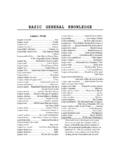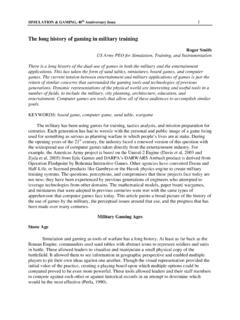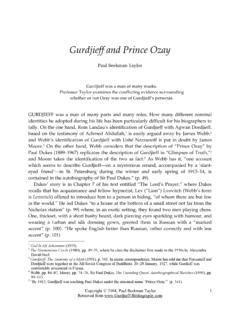Transcription of The US Chess Title System - glicko.net
1 The US Chess Title SystemUS Chess Ratings CommitteeFebruary 20161 Introduction and HistoryIn the 1994 and 1996 Ratings Committee reports, the Ratings Committee introduced and devel-oped a revision of the US Chess Title System which had been approved for implementation bythe Executive Board. The Title System was constructed to reward players with titles based onqualifying performances. Before the System was implemented, interest developed in devising amethod of rewarding achievement by keeping ratings above specified thresholds. This led to theLife Achievement proposal, which was approved by a new Executive Board in 1998.
2 Neither systemwas implemented. In 2003, a new call for implementing an updated version of the Title systemfrom the mid-1990s was requested. This revised System was approved by the Executive Board in2003, but once again fell through the cracks. Finally, in mid-2008, the US Chess went forwardwith the decision to implement the Title System . After about eight months of extensive discussionamong the Ratings Committee members, along with the hard work of Mike Nolan at the US Chessoffice who ran simulations of various versions of the Title System , the details of the System havebeen worked out. This document describes the technical details of this latest basic premise of the Title System is to award permanent titles based on sustained performancesat particular rating levels.
3 To be more concrete, a player who is vying for the 1800-level Title wouldneed to demonstrate several qualifying tournament performances in which his/her game resultswould be considered impressive for someone rated 1800. For each qualifying performance, a singlenorm is awarded. Once five norms are collected, a Title for that level is issued (subject to otherminor requirements such as having an established rating, etc.). Norms and titles cannot be lostthrough poor performance or inactivity. The new main features of the currently proposed systemare to add a minimum rating threshold for the upper-level titles, so that a player who earns fivenorms at the 2000-level Title (for example) must also have, or have had, an established rating of atleast 2000, and to simplify the eligibility criteria.
4 The Title System has no effect on the originalLife Master Title , which requires 300 games above a rating of The Norm CriteriaThe Title System is based on the principle that a player must have a sufficiently impressive perfor-mance relative to a player whose rating wasYto earn a norm at theY-rated level, and that theplayer must have five such performances to earn the Title . For example, to earn the 1st categorytitle (corresponding to a rating level of 1800), a player must have five performances that would beconsidered impressive for someone rated 1800, regardless of the player s actual rating. For opponentiwith post-event ratingRi, let i=Y Ri, that is, the difference between the Title level and the1opponent s rating.
5 Then defineCi= 0 if i + i/800 if 400< i + i/400 if 0< i 2001 if 200< i.(1)The valueCican be understood to be similar to a winning expectancy that is intentionally overop-timistic for opponents with ratings lower thanY. LetCT=C1+C2+..+Cnthe sum over allnopponents in the event, and letSTbe the player s total score in an event. Then a norm is earnedat theY-rating level ifST CT> that the inequality above is strict; ifST CT= 1 then a norm is on applications of this method to US Chess historical games data, roughly 10% of playersrated nearYwill earn theY-level Title in 5 years through normal tournament play, about 40% ofplayers rated nearY+ 100 will earn theY-level Title in 5 years, and roughly 70-80% of playersrated aroundY+ 200 will earn theY-level Title in 5 :Suppose a player without any norms has the following results in a 5-round event against playerswith the following post-event ratings: win against 1840, win against 1700, draw against 1900, drawagainst 1850, and loss against 1820.
6 Then the total score isST= The opponents post-eventratings areR1= 1840,R2= 1700,R3= 1900,R4= 1850 andR5= 1820. We now consider thenorm computation for all Title 1 records the values ofCifrom the formula for each opponent (columns) and for each titlelevel (rows). The sum of theCifor each Title level is displayed in the second-to-last column, andthe difference between the total score and the sum of theCiis in the final post-event ratingsTitleLevel (Y)18401700190018501820 CTST 1: For the example, values ofCifor each opponent and Title level combination, along withCT( , the sum of theCi), andST CTin the in the last two columns.
7 A norm is awarded whenthe value in the last column is greater than understand the computation that leads to the table entries, consider the calculations for the titlelevel of 1800. The values of the iare given by 1= 1800 1840 = 40, 2= 1800 1700 = 100, 3= 1800 1900 = 100, 4= 1800 1850 = 50, and 5= 1800 1820 = 20. Because2 400< 1 0,C1= + ( 40)/800 = ; 0< 2 200, soC2= + (100)/400 = ; andso player earns a norm at all Title levels in whichST CT> In this example, withST= ,the player has had a sufficiently strong performance to earn a norm at the 1200, 1400, and 1600title levels becauseST CT> in all three cases, but not the higher Title Norm and Title rulesThe following table specifies the set of titles, and whether a player needs to have attained anestablished rating above the rating level to earn the LevelTitleRating Requirement?
8 12004th CategoryNo14003rd CategoryNo16002nd CategoryNo18001st CategoryNo2000 Candidate MasterYes2200 Life MasterYes2400 Life Senior MasterYes1. Norms can only be earned in events of 4 rounds or A norm is earned toward aY- Title when a player s total score in an event exceeds the valueCT, the sum of theCigiven in equation (1), by , assuming four or more games have beenplayed. If only three games have been played, and a fourth game is either a bye (coded as B ) or a forfeit win (coded as X ), then the player s total score from the three games mustexceedCTby at least The computation forCiis computed relative to the opponent spost-event rating, not pre-event A player can earn norms regardless of being unrated, provisionally rated, or , to earn the Title , the player must have an established A player s results from an event apply simultaneously to every norm for titles not alreadyearned.
9 Thus, a player may be working on several titles at For the Candidate Master Title , the player must have had or currently has an establishedrating of at least 2000. For the Life Master Title , the player must have had or currently hasan established rating of at least 2200. For the Senior Life Master Title , the player must havehad or currently has an established rating of at least Norms can be earned only in events that are part of the US Chess regular rating System (include dual-rated events), and not in Quick-rated-only events, Blitz events, Online-Quickevents, Online-Blitz events or Correspondence Chess events.
10 Norms cannot be earned inmatches, or any event in which the player has competed against the same opponent morethan twice. If a player has multiple pairing numbers in an event ( , in an event withmultiple schedules that are merged together), the results under the combination of thosepairing numbers are treated as one when computing The current Title System has no effect on the original Life Master Title , which requires 300games above a rating of The current Title System has no effect on rating floors. For example, earning a 1st categorytitle does not imply a rating floor at The norm and Title computation will be applied retroactively to December 9, 1991, the dateafter which online records have been retained, to initialize a player s norm and Title who have not competed since that date and who are seeking titles may need to petitionon a case-by-case







